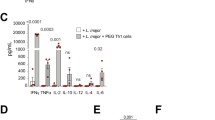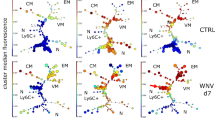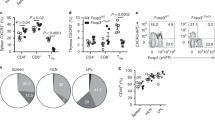Abstract
The long-term persistence of pathogens in a host that is also able to maintain strong resistance to reinfection, referred to as concomitant immunity, is a hallmark of certain infectious diseases, including tuberculosis and leishmaniasis. The ability of pathogens to establish latency in immune individuals often has severe consequences for disease reactivation1,2,3. Here we show that the persistence of Leishmania major in the skin after healing in resistant C57BL/6 mice is controlled by an endogenous population of CD4+CD25+ regulatory T cells. These cells constitute 5–10% of peripheral CD4+ T cells in naive mice and humans, and suppress several potentially pathogenic responses in vivo, particularly T-cell responses directed against self-antigens4. During infection by L. major, CD4+CD25+ T cells accumulate in the dermis, where they suppress—by both interleukin-10-dependent and interleukin-10-independent mechanisms—the ability of CD4+CD25- effector T cells to eliminate the parasite from the site. The sterilizing immunity achieved in mice with impaired IL-10 activity is followed by the loss of immunity to reinfection, indicating that the equilibrium established between effector and regulatory T cells in sites of chronic infection might reflect both parasite and host survival strategies.
This is a preview of subscription content, access via your institution
Access options
Subscribe to this journal
Receive 51 print issues and online access
$199.00 per year
only $3.90 per issue
Buy this article
- Purchase on Springer Link
- Instant access to full article PDF
Prices may be subject to local taxes which are calculated during checkout




Similar content being viewed by others
References
el Hassan, A. M. et al. Post kala-azar dermal leishmaniasis in the Sudan: clinical features, pathology and treatment. Trans. R. Soc. Trop. Med. Hyg. 86, 245–248 (1992)
Momeni, A. Z. & Aminjavaheri, M. Clinical picture of cutaneous leishmaniasis in Isfahan, Iran. Int. J. Dermatol. 33, 260–265 (1994)
Alvar, J. et al. Leishmania and human immunodeficiency virus coinfection: the first 10 years. Clin. Microbiol. Rev. 10, 298–319 (1997)
Shevach, E. M. CD4 + CD25 + suppressor T cells: more questions than answers. Nature Rev. Immunol. 2, 389–400 (2002)
Sakaguchi, S., Sakaguchi, N., Asano, M., Itoh, M. & Toda, M. Immunologic self-tolerance maintained by activated T cells expressing IL-2 receptor alpha-chains (CD25). Breakdown of a single mechanism of self-tolerance causes various autoimmune diseases. J. Immunol. 155, 1151–1164 (1995)
Thornton, A. M. & Shevach, E. M. CD4 + CD25 + immunoregulatory T cells suppress polyclonal T cell activation in vitro by inhibiting interleukin 2 production. J. Exp. Med. 188, 287–296 (1998)
Piccirillo, C. A. et al. CD4 + CD25 + regulatory T cells can mediate suppressor function in the absence of transforming growth factorβ1 production and responsivenes. J. Exp. Med. 196, 237–246 (2002)
Papiernik, M., de Moraes, M. L., Pontoux, C., Vasseur, F. & Penit, C. Regulatory CD4 T cells: expression of IL-2R alpha chain, resistance to clonal deletion and IL-2 dependency. Int. Immunol. 10, 371–378 (1998)
Belkaid, Y. et al. The role of interleukin (IL)-10 in the persistence of Leishmania major in the skin after healing and the therapeutic potential of anti-IL-10 receptor antibody for sterile cure. J. Exp. Med. 194, 1497–1506 (2001)
Belkaid, Y. et al. A natural model of Leishmania major infection reveals a prolonged ‘silent’ phase of parasite amplification in the skin before the onset of lesion formation and immunity. J. Immunol. 165, 969–977 (2000)
Piccirillo, C. A. & Shevach, E. M. Cutting edge: control of CD8 + T cell activation by CD4 + CD25 + immunoregulatory cells. J. Immunol. 167, 1137–1140 (2001)
Cederbom, L., Hall, H. & Ivars, F. CD4 + CD25 + regulatory T cells down-regulate co-stimulatory molecules on antigen-presenting cells. Eur. J. Immunol. 30, 1538–1543 (2000)
Read, S., Malmstrom, V. & Powrie, F. Cytotoxic T lymphocyte-associated antigen 4 plays an essential role in the function of CD25+CD4+ regulatory cells that control intestinal inflammation. J. Exp. Med. 192, 295–302 (2000)
Gazzinelli, R. T., Oswald, I. P., James, S. L. & Sher, A. IL-10 inhibits parasite killing and nitrogen oxide production by IFN-γ-activated macrophages. J. Immunol. 148, 1792–1796 (1992)
Mendez, S. et al. The potency and durability of DNA- and protein-based vaccines against Leishmania major evaluated using low-dose, intradermal challenge. J. Immunol. 166, 5122–5128 (2001)
Karp, C. L. et al. In vivo cytokine profiles in patients with kala-azar. Marked elevation of both interleukin-10 and interferon-gamma. J. Clin. Invest. 91, 1644–1648 (1993)
Gasim, S. et al. High levels of plasma IL-10 and expression of IL-10 by keratinocytes during visceral leishmaniasis predict subsequent development of post-kala-azar dermal leishmaniasis. Clin. Exp. Immunol. 111, 64–69 (1998)
Powrie, F., Correa-Oliveira, R., Mauze, S. & Coffman, R. L. Regulatory interactions between CD45RBhigh and CD45RBlow CD4+ T cells are important for the balance between protective and pathogenic cell-mediated immunity. J. Exp. Med. 179, 589–600 (1994)
Gerosa, F. et al. CD4+ T cell clones producing both interferon-gamma and interleukin-10 predominate in bronchoalveolar lavages of active pulmonary tuberculosis patients. Clin. Immunol. 92, 224–234 (1999)
Plebanski, M. et al. Interleukin 10-mediated immunosuppression by a variant CD4 T cell epitope of Plasmodium falciparum. Immunity 10, 651–660 (1999)
Jankovic, D. et al. In the absence of IL-12, CD4+ T cell responses to intracellular pathogens fail to default to a Th2 pattern and are host protective in an IL-10-/- setting. Immunity 16, 429–439 (2002)
Ostrowski, M. A. et al. Quantitative and qualitative assessment of human immunodeficiency virus type 1 (HIV-1)-specific CD4 + T cell immunity to gag in HIV-1-infected individuals with differential disease progression: reciprocal interferon-gamma and interleukin-10 responses. J. Infect. Dis. 184, 1268–1278 (2001)
Uzonna, J. E., Wei, G., Yurkowski, D. & Bretscher, P. Immune elimination of Leishmania major in mice: implications for immune memory, vaccination, and reactivation disease. J. Immunol. 167, 6967–6974 (2001)
O'Farrell, A. M., Liu, Y., Moore, K. W. & Mui, A. L. IL-10 inhibits macrophage activation and proliferation by distinct signaling mechanisms: evidence for Stat3-dependent and -independent pathways. EMBO J. 17, 1006–1018 (1998)
von Stebut, E., Belkaid, Y., Jakob, T., Sacks, D. L. & Udey, M. C. Uptake of Leishmania major amastigotes results in activation and interleukin 12 release from murine skin-derived dendritic cells: implications for the initiation of anti-Leishmania immunity. J. Exp. Med. 188, 1547–1552 (1998)
Lutz, M. B. et al. An advanced culture method for generating large quantities of highly pure dendritic cells from mouse bone marrow. J. Immunol. Methods 223, 77–92 (1999)
Acknowledgements
We thank C. Eigsti and K. Holmes of the Flow Cytometry Unit for FACS sorting, S. Cooper for help with the mouse care, S. Hieny for providing Toxoplasma gondii tachyzoites, M. Udey for helpful discussion, and A. Sher and G. Milon for critical reading of the manuscript.
Author information
Authors and Affiliations
Corresponding author
Ethics declarations
Competing interests
The authors declare that they have no competing financial interests.
Rights and permissions
About this article
Cite this article
Belkaid, Y., Piccirillo, C., Mendez, S. et al. CD4+CD25+ regulatory T cells control Leishmania major persistence and immunity. Nature 420, 502–507 (2002). https://doi.org/10.1038/nature01152
Received:
Accepted:
Issue Date:
DOI: https://doi.org/10.1038/nature01152
This article is cited by
-
Antigen recognition reinforces regulatory T cell mediated Leishmania major persistence
Nature Communications (2023)
-
Pathogenic Interleukin-10 Receptor Alpha Variants in Humans — Balancing Natural Selection and Clinical Implications
Journal of Clinical Immunology (2023)
-
Local assessment of the immunohistochemical expression of Foxp3+ regulatory T lymphocytes in the different pathological forms associated with bovine paratuberculosis
BMC Veterinary Research (2022)
-
Concomitant immunity to M. tuberculosis infection
Scientific Reports (2022)
-
CD4 expression in effector T cells depends on DNA demethylation over a developmentally established stimulus-responsive element
Nature Communications (2022)
Comments
By submitting a comment you agree to abide by our Terms and Community Guidelines. If you find something abusive or that does not comply with our terms or guidelines please flag it as inappropriate.



